check engine YAMAHA XL 1200 2001 User Guide
[x] Cancel search | Manufacturer: YAMAHA, Model Year: 2001, Model line: XL 1200, Model: YAMAHA XL 1200 2001Pages: 131, PDF Size: 8.12 MB
Page 63 of 131

3-6
E
EJU00426
Pre-operation check points
Engine compartment
Ventilate the engine compar tment before
each use.
To ventilate the engine compartment,
remove all seats and front storage compart-
ment. (See pages 2-5 and 2-6 for front and
rear seat, and 2-30 for front storage com-
partment.) Allow the engine compartment to
remain open for a few minutes to allow any
fuel vapors to escape. Also, check for loose
electrical connections.
WARNING
Failure to ventilate the engine compart-
ment could result in fire or explosion. Do
not start the engine if there is a fuel leak
or a loose electrical connection.
EJU00427-30a
Fuel and oil systems
Check the fuel system for leakage, cracks
or malfunctions before each use. (See page
4-9 for check points and correct proce-
dures.)
1. Remove the fuel tank filler cap to release
any pressure that might have built up in
the fuel tank.
2. Remove all seats and front storage com-
partment. (See pages 2-5 and 2-6 for
front and rear seat, and 2-30 for front
storage compartment.)
3. Check the fuel and oil levels in the tanks
and replenish if necessary. (See pages 3-3
and 3-4 for filling instructions.)
Page 64 of 131
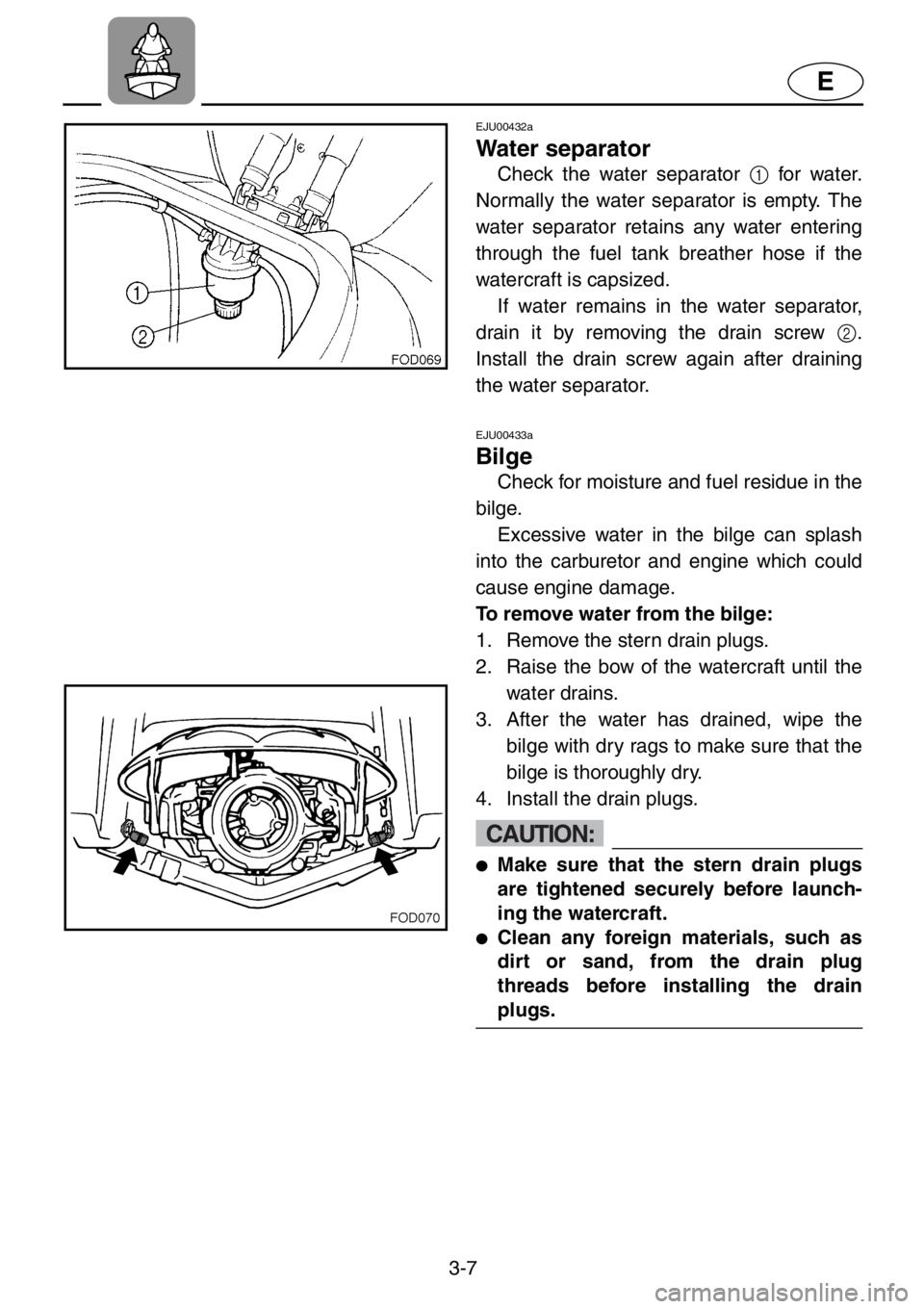
3-7
E
EJU00432a
Water separator
Check the water separator 1 for water.
Normally the water separator is empty. The
water separator retains any water entering
through the fuel tank breather hose if the
watercraft is capsized.
If water remains in the water separator,
drain it by removing the drain screw 2.
Install the drain screw again after draining
the water separator.
EJU00433a
Bilge
Check for moisture and fuel residue in the
bilge.
Excessive water in the bilge can splash
into the carburetor and engine which could
cause engine damage.
To remove water from the bilge:
1. Remove the stern drain plugs.
2. Raise the bow of the watercraft until the
water drains.
3. After the water has drained, wipe the
bilge with dry rags to make sure that the
bilge is thoroughly dry.
4. Install the drain plugs.
CAUTION:
●Make sure that the stern drain plugs
are tightened securely before launch-
ing the watercraft.
●Clean any foreign materials, such as
dirt or sand, from the drain plug
threads before installing the drain
plugs.
Page 65 of 131
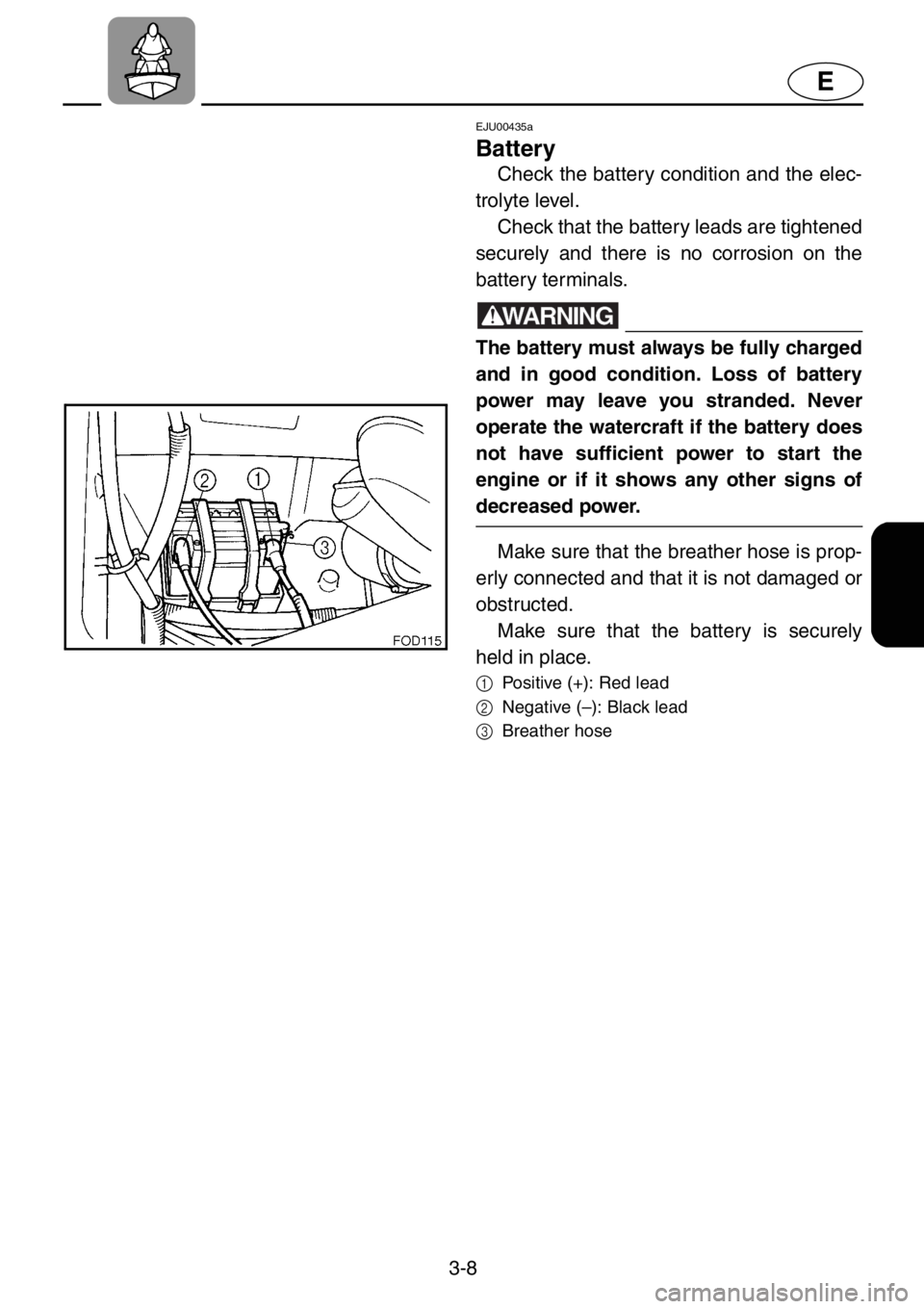
3-8
E
EJU00435a
Battery
Check the battery condition and the elec-
trolyte level.
Check that the battery leads are tightened
securely and there is no corrosion on the
battery terminals.
WARNING
The battery must always be fully charged
and in good condition. Loss of battery
power may leave you stranded. Never
operate the watercraft if the battery does
not have sufficient power to start the
engine or if it shows any other signs of
decreased power.
Make sure that the breather hose is prop-
erly connected and that it is not damaged or
obstructed.
Make sure that the battery is securely
held in place.
1
Positive (+): Red lead
2
Negative (–): Black lead
3
Breather hose
Page 67 of 131
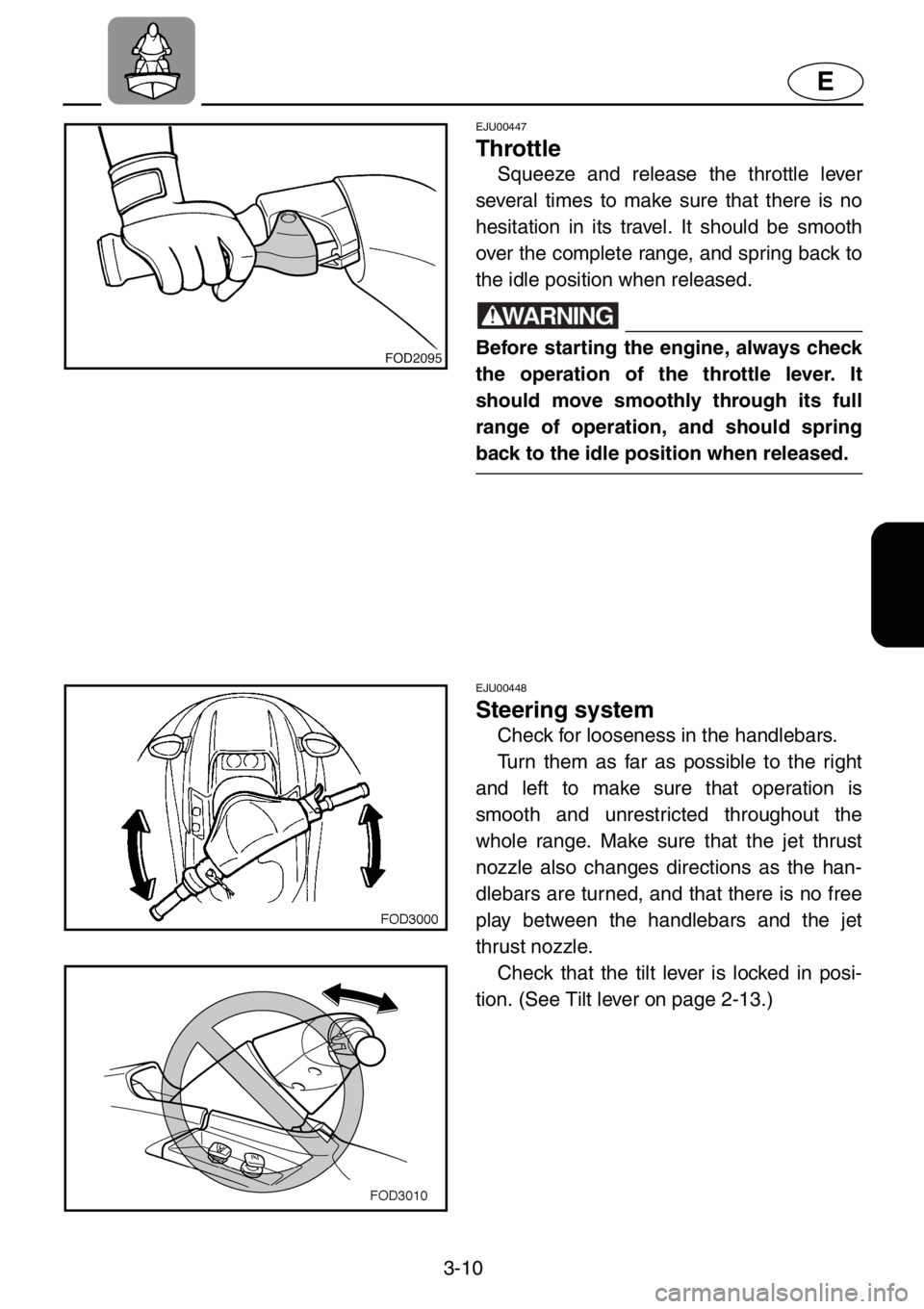
3-10
E
EJU00447
Throttle
Squeeze and release the throttle lever
several times to make sure that there is no
hesitation in its travel. It should be smooth
over the complete range, and spring back to
the idle position when released.
WARNING
Before starting the engine, always check
the operation of the throttle lever. It
should move smoothly through its full
range of operation, and should spring
back to the idle position when released.
EJU00448
Steering system
Check for looseness in the handlebars.
Turn them as far as possible to the right
and left to make sure that operation is
smooth and unrestricted throughout the
whole range. Make sure that the jet thrust
nozzle also changes directions as the han-
dlebars are turned, and that there is no free
play between the handlebars and the jet
thrust nozzle.
Check that the tilt lever is locked in posi-
tion. (See Tilt lever on page 2-13.)
Page 68 of 131

3-11
E
EJU00450
Shift lever and reverse gate
Check for proper operation of the shift
lever and reverse gate.
Make sure that the reverse gate goes
down to its stopper position when the shift
lever is pulled up.
Also, make sure that the reverse gate
goes up to its stopper position when shift
lever is pushed down.
WARNINGJJ●Make sure that the throttle is com-
pletely released and that the engine is
at idle before shifting into reverse.
●Do not use the reverse function to
slow down or stop the watercraft as it
could cause you to lose control, be
ejected, or impact the handlebars.
●Use reverse for slow-speed maneuver-
ing only.
●Make sure that there are no obstacles
or people behind you before shifting
into reverse.
●Do not touch the reverse gate while the
shift lever is being operated, otherwise
you could be pinched.
Page 69 of 131
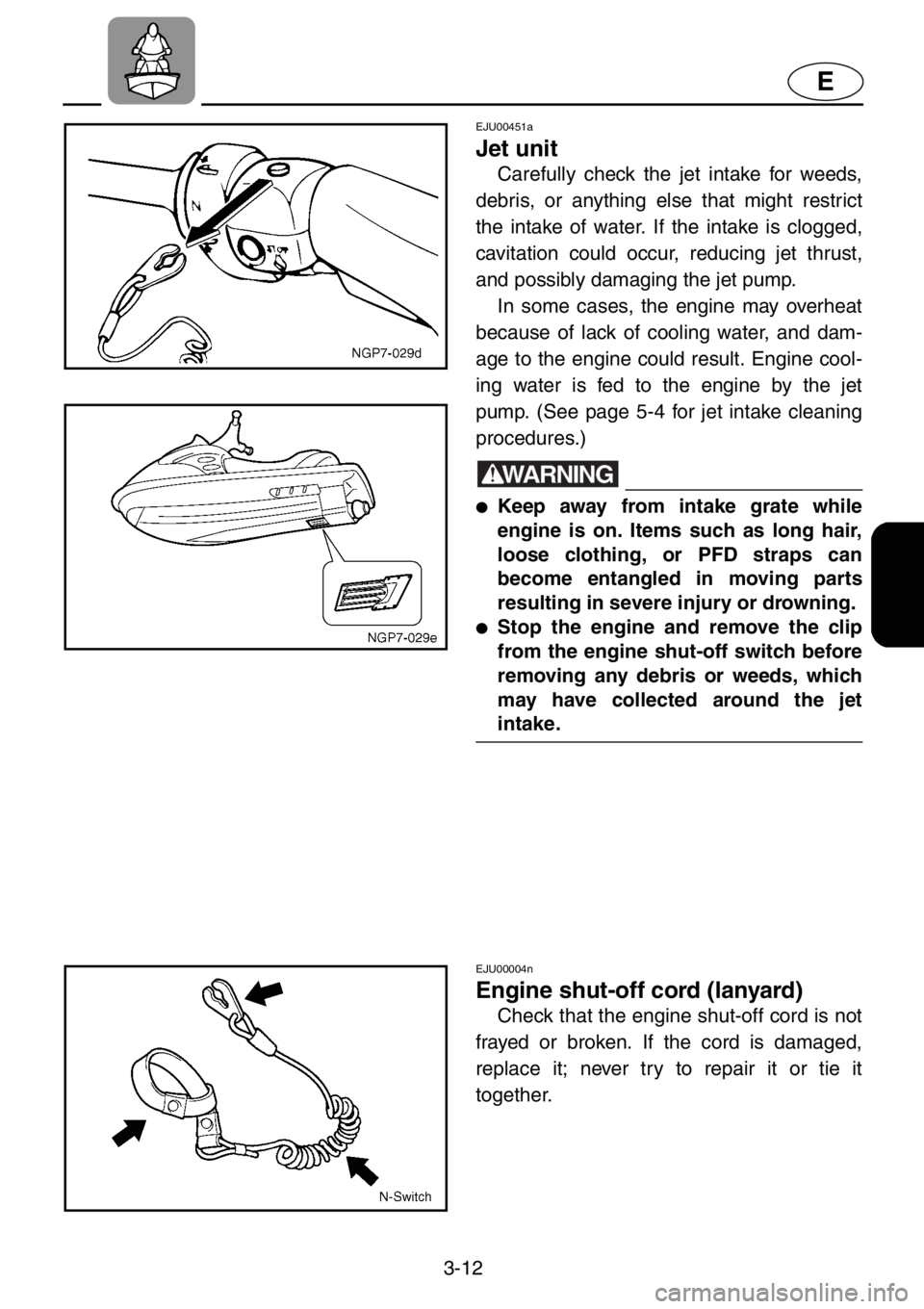
3-12
E
EJU00451a
Jet unit
Carefully check the jet intake for weeds,
debris, or anything else that might restrict
the intake of water. If the intake is clogged,
cavitation could occur, reducing jet thrust,
and possibly damaging the jet pump.
In some cases, the engine may overheat
because of lack of cooling water, and dam-
age to the engine could result. Engine cool-
ing water is fed to the engine by the jet
pump. (See page 5-4 for jet intake cleaning
procedures.)
WARNING
●Keep away from intake grate while
engine is on. Items such as long hair,
loose clothing, or PFD straps can
become entangled in moving parts
resulting in severe injury or drowning.
●Stop the engine and remove the clip
from the engine shut-off switch before
removing any debris or weeds, which
may have collected around the jet
intake.
EJU00004n
Engine shut-off cord (lanyard)
Check that the engine shut-off cord is not
frayed or broken. If the cord is damaged,
replace it; never try to repair it or tie it
together.
Page 70 of 131

3-13
E
EJU00452a
Switches
Check the start switch 1, the engine stop
switch 2, and the engine shut-off switch 3
for proper operation.
To check these switches place the water-
craft in the water to provide adequate cooling.
Start the engine, and then pull the engine
shut-off cord 5 to remove the clip 4 from the
engine shut-off switch. Verify that the engine
stops immediately. (See pages 3-16 to 3-19
for information on proper operation of the
start switch, the engine stop switch and the
engine shut-off switch.)
EJU00453
Cooling water pilot outlet
Check that water comes out from the out-
let while the engine is running and the
watercraft is in the water.
EJU00454
Multifunction meter
Check the operation of the multifunction
meter. (See pages 2-20 to 2-29 for operation
of the meter.)
Page 74 of 131
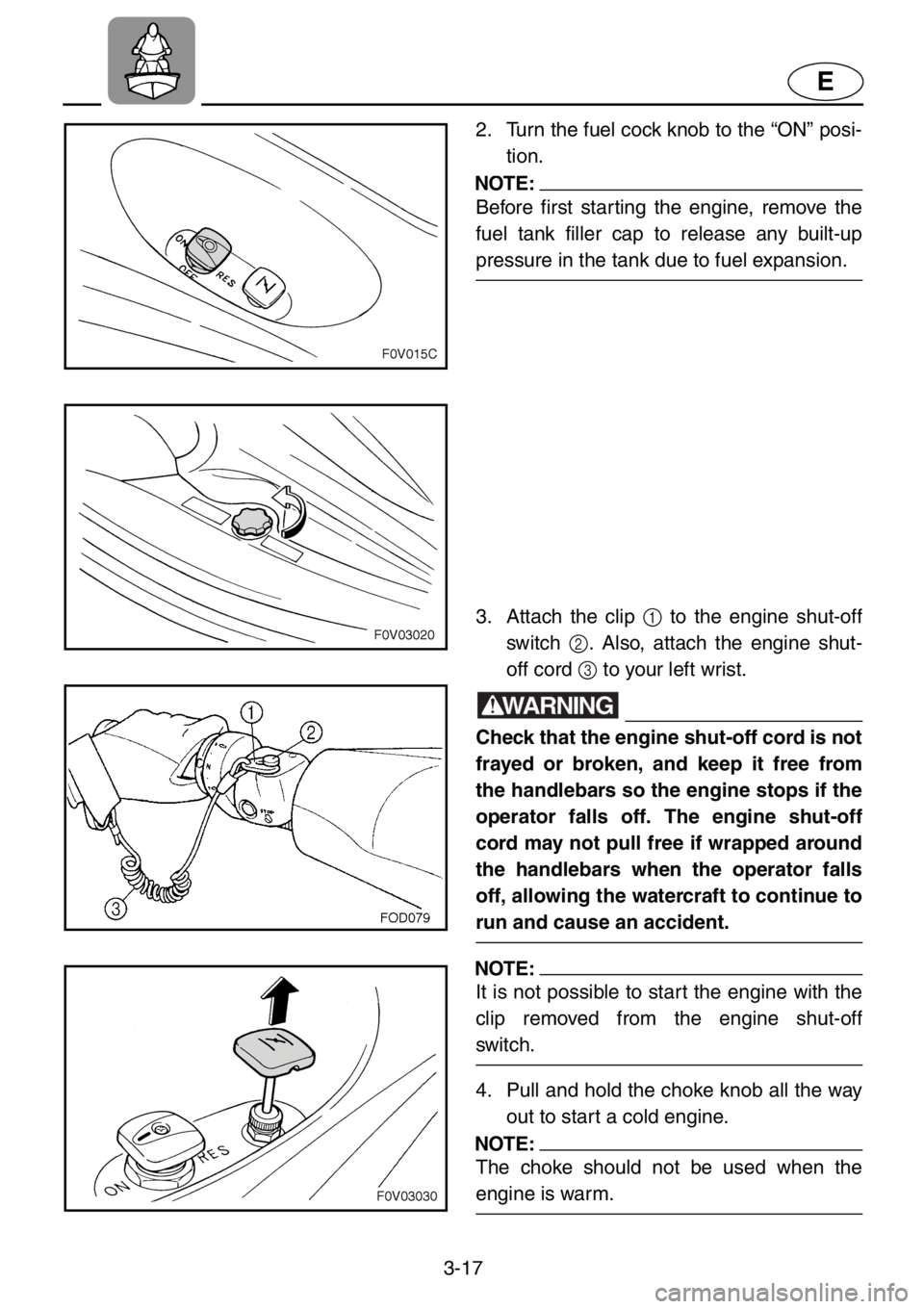
3-17
E
2. Turn the fuel cock knob to the “ON” posi-
tion.
NOTE:
Before first starting the engine, remove the
fuel tank filler cap to release any built-up
pressure in the tank due to fuel expansion.
3. Attach the clip 1 to the engine shut-off
switch 2. Also, attach the engine shut-
off cord 3 to your left wrist.
WARNING
Check that the engine shut-off cord is not
frayed or broken, and keep it free from
the handlebars so the engine stops if the
operator falls off. The engine shut-off
cord may not pull free if wrapped around
the handlebars when the operator falls
off, allowing the watercraft to continue to
run and cause an accident.
NOTE:
It is not possible to start the engine with the
clip removed from the engine shut-off
switch.
4. Pull and hold the choke knob all the way
out to start a cold engine.
NOTE:
The choke should not be used when the
engine is warm.
Page 77 of 131
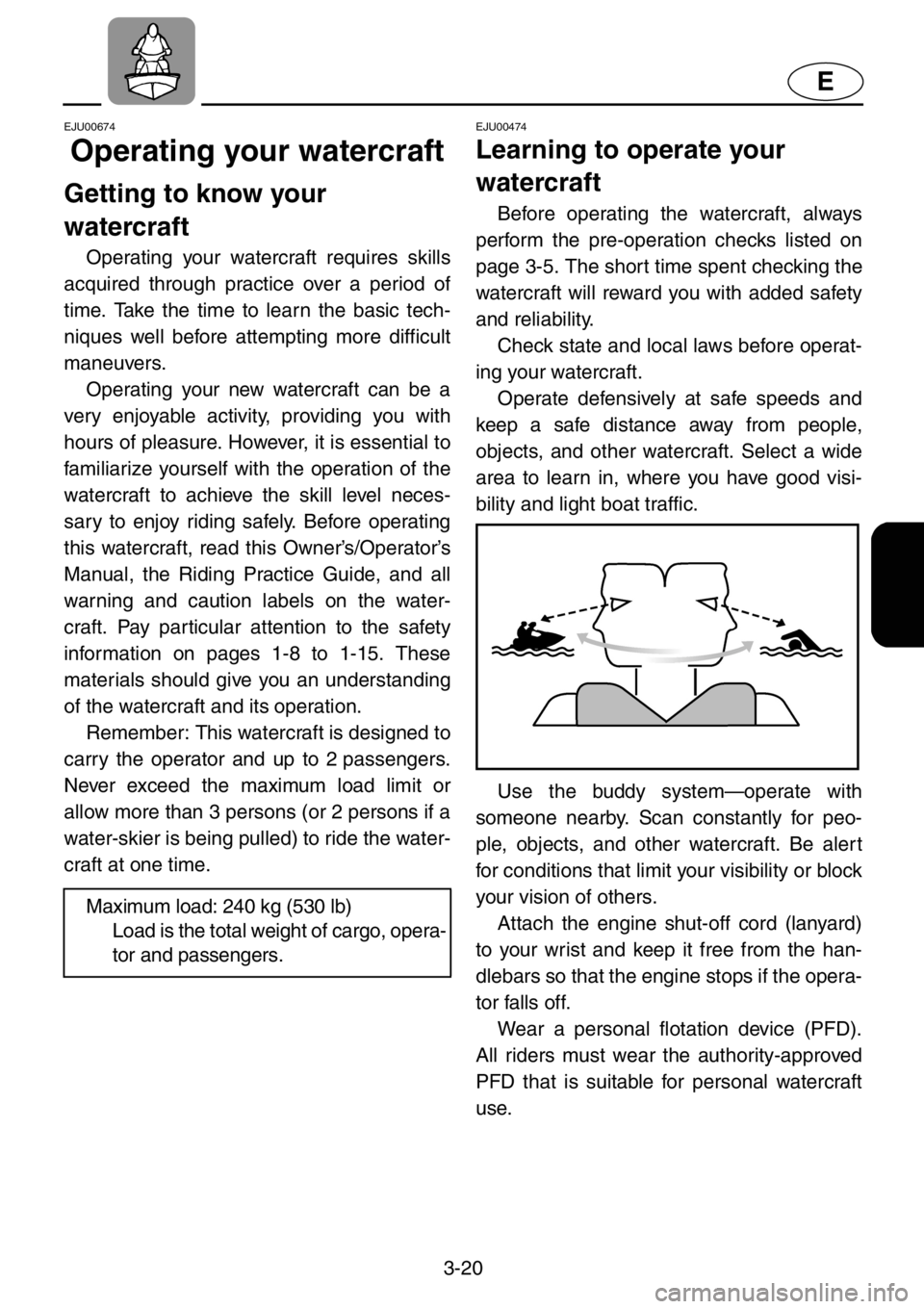
3-20
E
EJU00674
Operating your watercraft
Getting to know your
watercraft
Operating your watercraft requires skills
acquired through practice over a period of
time. Take the time to learn the basic tech-
niques well before attempting more difficult
maneuvers.
Operating your new watercraft can be a
very enjoyable activity, providing you with
hours of pleasure. However, it is essential to
familiarize yourself with the operation of the
watercraft to achieve the skill level neces-
sary to enjoy riding safely. Before operating
this watercraft, read this Owner’s/Operator’s
Manual, the Riding Practice Guide, and all
warning and caution labels on the water-
craft. Pay particular attention to the safety
information on pages 1-8 to 1-15. These
materials should give you an understanding
of the watercraft and its operation.
Remember: This watercraft is designed to
carry the operator and up to 2 passengers.
Never exceed the maximum load limit or
allow more than 3 persons (or 2 persons if a
water-skier is being pulled) to ride the water-
craft at one time.
EJU00474
Learning to operate your
watercraft
Before operating the watercraft, always
perform the pre-operation checks listed on
page 3-5. The short time spent checking the
watercraft will reward you with added safety
and reliability.
Check state and local laws before operat-
ing your watercraft.
Operate defensively at safe speeds and
keep a safe distance away from people,
objects, and other watercraft. Select a wide
area to learn in, where you have good visi-
bility and light boat traffic.
Use the buddy system—operate with
someone nearby. Scan constantly for peo-
ple, objects, and other watercraft. Be alert
for conditions that limit your visibility or block
your vision of others.
Attach the engine shut-off cord (lanyard)
to your wrist and keep it free from the han-
dlebars so that the engine stops if the opera-
tor falls off.
Wear a personal flotation device (PFD).
All riders must wear the authority-approved
PFD that is suitable for personal watercraft
use. Maximum load: 240 kg (530 lb)
Load is the total weight of cargo, opera-
tor and passengers.
Page 82 of 131

3-25
E
EJU00737a
Boarding with passengers
WARNING
Severe internal injuries can occur if
water is forced into body cavities as a
result of being near the jet thrust nozzle.
Do not apply throttle until each passen-
ger is seated with his or her feet on the
floor of the footwell and is holding on to
the person in front of him or her.
1. Climb on board as noted in the previous
section, and sit astride the seat. Attach
the engine shut-off cord to your wrist,
and then install the clip to the engine
shut-off switch.
2. Have the passenger move to the rear of
the watercraft.
3. Have the passenger get on board and sit
on the seat. If a second passenger is
getting on, have him or her follow the
same procedure.
NOTE:
When a passenger is getting on board, both
he and the operator should try to balance
the watercraft.
4. The operator should check to see that
the passengers have their feet on the
floor of the footwell and that they are
securely holding on to the person in front
of them.
5. Start the engine, look in all directions,
and then accelerate to planing speed.
WARNING
Before starting off, make sure that there
are no boats, obstructions, or swimmers
around you.